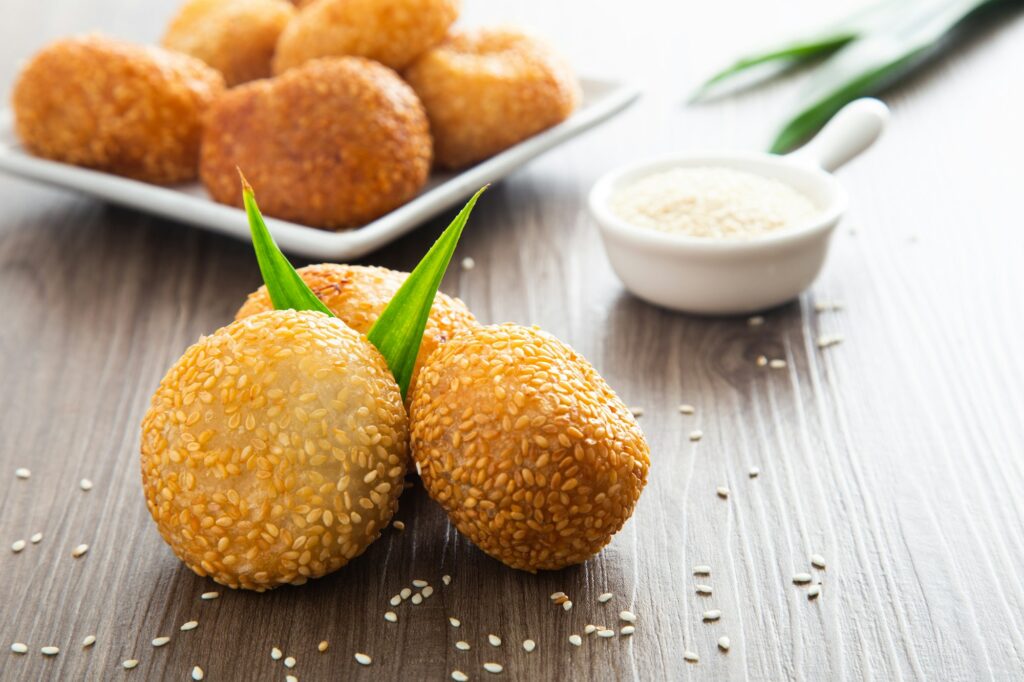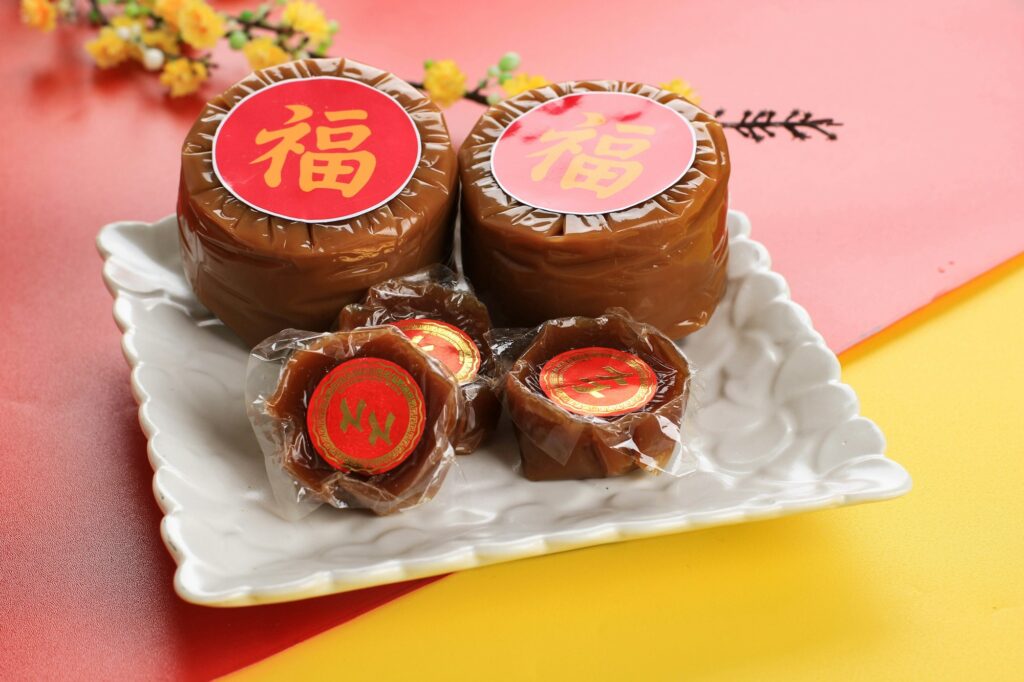The world of Asian dessert recipes is as diverse and rich as the continent itself. From the sweet and sticky rice cakes of Korea to the delicate matcha treats of Japan, each country brings its own unique flavors and traditions to the table. These sweet treats have gained global appeal, captivating food enthusiasts and home cooks around the world with their unique ingredients, textures, and flavors. In this comprehensive guide, we will embark on a culinary journey, exploring the most popular Asian dessert recipes, their cultural significance, and modern twists that keep these age-old traditions alive in contemporary kitchens.
Popular Asian Dessert Recipes
Korean Desserts
- Sweet Rice Cakes with Honey: A staple in Korean dessert culture, these rice cakes are a simple yet delightful treat. Made from steamed rice flour and filled or coated with honey, they exemplify the elegance of Korean sweets.
- Black Sesame Cookies: Incorporating the nutty and rich flavor of black sesame, these cookies offer a unique taste experience. They blend traditional Korean flavors with the familiar form of a cookie.
- Korean Steamed Pear (Baesuk): Baesuk is a comforting, warm dessert perfect for cold days or aiding in recovery from a cold, showcasing the versatility of Asian desserts in both taste and application.
- Dalgona Candy and Coffee: Following global trends, Dalgona candy and coffee have become symbols of Korean innovative sweets, combining simple ingredients to create texturally complex and flavorful desserts.
Japanese Desserts
- Castella Cake: A sponge cake brought by the Portuguese to Japan, Castella is a moist, honey-flavored cake that has been adopted and refined by Japanese pastry chefs.
- Matcha-Based Desserts: Matcha, the finely ground, bright green tea powder, is at the heart of countless Japanese desserts, from cookies and cheesecakes to the traditional mochi.
- Mochi Varieties and Mochi Muffin: Mochi, a chewy treat made from glutinous rice, is versatile. We can fill it with sweet bean paste or ice cream, or even baked into a muffin, demonstrating the adaptability of traditional ingredients in new forms.
Indian Desserts
- Kulfi: Often referred to as Indian ice cream, Kulfi is denser and creamier. Made with condensed milk, it’s flavored with cardamom, saffron, and pistachios, offering a rich taste of Indian tradition.
- Modak: We fill these sweet dumplings with coconut and jaggery, marking their importance in religious and cultural festivities in India.
- Gulab Jamun and Motichur Laddu: Deep-fried and soaked in syrup, Gulab Jamun, along with the fragrant Motichur Laddu, showcases the indulgent side of Asian sweets.
Thai and Vietnamese Desserts
- Thai Fried Bananas (Kluai Khaek): A street food favorite, these bananas are coated in a crispy batter and often served hot, offering a perfect example of Thai innovation in desserts.
- Vietnamese Avocado Mousse Ice Cream (Kem Bo): This dessert blends the creaminess of avocado with the sweetness of condensed milk, topped with coconut flakes, representing the fresh and vibrant flavors of Vietnam.
Chinese Desserts
- Chinese Nougat: A sweet confectionery that combines roasted peanuts, marshmallows, and powdered milk to create a chewy and sweet treat.
- Nian Gao (Chinese New Year Cake): A traditional dessert served during Chinese New Year, Nian Gao is made from glutinous rice and symbolizes prosperity and growth.
Each of these Asian dessert recipes showcases the unique ingredients and culinary techniques of their respective cultures. From the simplicity of steamed pears to the complexity of matcha-based desserts, the variety of flavors and textures is boundless.
Ingredients and Preparation of Asian Desserts
The magic of Asian dessert recipes lies not just in their flavors but also in the unique ingredients and preparation methods that define them. We can attribute the diversity of Asian sweets to a rich palette of ingredients, ranging from glutinous rice flour and matcha powder to more exotic components like black sesame seeds and jujube. These ingredients not only add distinctive flavors but also health benefits, making Asian desserts not just a treat for the taste buds but also a nod to traditional healing practices.
Common Ingredients Across Various Asian Desserts:
- Glutinous rice flour is a staple in mochi and nian gao, providing a chewy texture.
- Matcha powder, known for its bright color and health benefits, is used in a variety of Japanese desserts.
- Coconut milk and pandan leaves common in Thai and Vietnamese desserts, imparting a fragrant aroma and creamy texture.
Unique Preparation Methods:
- Steaming, as seen in the Korean steamed pear (Baesuk) and Chinese nian gao, is a preferred method, preserving the ingredients’ natural flavors and nutrients.
- The process of deep-frying, used in making Thai fried bananas and Indian gulab jamun, adds a crispy texture to the soft interiors.
- The art of molding and shaping is crucial in desserts like modak and mochi, where the dessert’s presentation is as important as its taste.
These ingredients and methods are deeply rooted in the culinary traditions of each region, reflecting the cultural significance and history of these dessert recipes. For instance, the use of pandan in Thai desserts or the intricate process of making mochi by hand speaks volumes about the craftsmanship and pride that go into creating these sweet treats.
Moreover, the preparation of Asian desserts often involves a communal aspect, with families coming together for the intricate steps required in recipes like modak during Ganesh Chaturthi or the making of mochi for Japanese New Year celebrations. This communal aspect not only enhances the flavor of the desserts but also enriches the cultural experience, making Asian sweets a gateway to exploring the rich tapestry of Asian traditions.
Modern Twists on Traditional Recipes
The innovation within Asian dessert recipes does not stop at their traditional forms. Chefs and home cooks alike have been bringing modern twists to these traditional Asian desserts, blending them with Western techniques or incorporating new ingredients to create fusion dishes that bridge cultures and tastes.
Fusion Recipes:
- Matcha Cheesecake combines the traditional Japanese tea flavor with the creamy texture of a Western cheesecake, offering a rich, nuanced dessert that appeals to a broad audience.
- Dalgona Coffee, though not a dessert per se, exemplifies how traditional ingredients can be used in new, trendy ways to captivate a global audience.
Modern Variations:
- Vegan Asian desserts are on the rise, with traditional recipes being modified to use plant-based ingredients. For example, coconut milk is often used as a dairy substitute in kulfi or mochi to cater to vegan diets.
- Gluten-free options are also becoming more prevalent, with rice flour and almond flour replacing wheat in recipes like cookies and cakes, making these treats accessible to those with dietary restrictions.
Incorporation of Traditional Elements into New Dessert Forms:
- The essence of pandan is being used in innovative ways, such as in pandan-flavored layer cakes or cupcakes, marrying the aromatic, herbal notes of pandan with familiar Western dessert formats.
- Black sesame has found its way into ice creams and lattes, introducing its distinct, nutty flavor to a wider range of dessert options.
These modern adaptations not only make Asian sweets more accessible to a global palate but also demonstrate the versatility and adaptability of traditional ingredients. By respecting the essence of the original dessert recipes while daring to experiment, these modern twists contribute to the ongoing evolution of Asian cuisine.
The fusion of traditional Asian desserts with contemporary culinary trends reflects a growing appreciation for multicultural flavors and the desire for innovation in the kitchen. As these desserts continue to evolve, they invite us to explore new flavor combinations and appreciate the rich cultural heritage behind each bite. Whether you’re a seasoned chef or a curious home cook, the world of Asian desserts offers endless possibilities for creativity and discovery.
Healthier Alternatives in Asian Desserts
In recent years, there’s been a notable shift towards healthier eating trends, and Asian dessert recipes have kept up with it. This movement has led to the creation of lighter, more nutritious versions of traditional sweets, without compromising on their authentic tastes and textures. The focus is on utilizing natural sweeteners, whole grains, and plant-based ingredients to craft healthy dessert options that one can enjoy guilt-free.
Natural Sweeteners:
Many Asian cultures have a long history of using natural sweeteners like jaggery, honey, and dates in their desserts. These ingredients not only add a rich depth of flavor but also provide minerals and vitamins not found in refined sugar. For example, modak sweetened with jaggery is a healthier alternative that maintains the traditional taste profile.
Whole Grains and Flours:
The use of whole grains and flours such as brown rice flour, almond flour, and coconut flour in place of refined flours boosts the nutritional profile of desserts. These ingredients offer higher fiber content and a lower glycemic index, making desserts like glutinous rice ball with crushed peanuts or matcha green tea cookies more nutritious.
Plant-based Ingredients:
With the rise of veganism, there has been an innovative use of plant-based ingredients in Asian desserts. Coconut milk, almond milk, and tofu have become popular substitutes for dairy, providing creamy textures and enriching flavors while keeping the recipes vegan and lactose-free. Vietnamese avocado mousse ice cream made with coconut milk is a delightful example of such an adaptation.
These healthier alternatives not only cater to dietary restrictions and preferences but also align with a growing global consciousness around food and wellness. By making small adjustments to traditional recipes, it’s possible to enjoy the rich, comforting flavors of Asian sweets in a way that’s both delicious and nutritious.
Cultural Significance of Asian Desserts
Asian desserts are much more than just the final course of a meal; they are a vibrant expression of cultural heritage, tradition, and communal values. Each dessert tells a story, whether it’s of seasonal celebrations, religious ceremonies, or everyday life, and plays a crucial role in connecting generations.
Festive Sweets:
Certain desserts are integral to celebrations and festivities across Asia. For instance, mooncakes are synonymous with the Mid-Autumn Festival in Chinese culture, while in India, sweets like gulab jamun and motichur laddu are essential for Diwali. These desserts are not just food items but symbols of prosperity, happiness, and the sharing of good fortune.
Historical Roots:
Many Asian dessert recipes have deep historical roots, tracing back centuries. Their origins often reflect the trade routes, agricultural practices, and cultural exchanges of the time, showcasing the rich tapestry of Asia’s history. For example, the Portuguese influence on Japanese Castella cake is a testament to the early interactions between Japan and the Western world.
Communal and Family Bonds:
The preparation of many Asian desserts is a communal activity that strengthens family and community bonds. The making of mochi in Japan during the New Year or kulfi in Indian households during summer brings people together, creating memories and reinforcing social ties.
FAQs Section
In this final section, we’ll address some frequently asked questions about Asian desserts, providing insights that can help deepen your appreciation and understanding of these delightful treats.
Q: What makes Asian desserts unique?
A: Asian desserts stand out due to their diverse use of ingredients, textures, and preparation methods. Unlike Western desserts, which often rely heavily on dairy and wheat flour, Asian sweets frequently utilize rice flour, beans, and various types of starches. This not only contributes to their unique textures—ranging from chewy and sticky to light and airy—but also to a wide array of flavors enhanced with ingredients like matcha, sesame, and tropical fruits. Their uniqueness also lies in the cultural and ceremonial roles they play in their countries of origin.
Q: Can Asian desserts be made vegan or gluten-free?
A: Yes, many Asian desserts naturally align with vegan and gluten-free diets to meet these dietary needs. For instance, mochi, traditionally made from glutinous rice flour, is naturally gluten-free. You can make desserts like kulfi vegan by substituting dairy milk with coconut or almond milk. The flexibility and diversity of ingredients in Asian cuisine make it relatively simple to modify recipes without compromising their authentic taste.
Conclusion
Exploring the vibrant world of Asian desserts offers a unique lens through which to experience and appreciate the rich culinary traditions of Asia. From the chewy delight of mochi to the sweet and creamy kulfi, each dessert tells a story of cultural heritage, seasonal celebrations, and communal joy. Through this journey, we’ve discovered the vast array of flavors and textures that make Asian sweets so enticing.
The resurgence of interest in healthier alternatives and the fusion of traditional with contemporary culinary practices reflect a global appreciation for the diversity and adaptability of Asian cuisine. These desserts are more than just a treat for the palate; they are an invitation to explore, understand, and connect with the cultures from which they originate.
We encourage you to continue exploring, tasting, and creating, letting the rich tapestry of Asian desserts inspire your culinary adventures. With each bite, you partake in a centuries-old tradition of celebration, creativity, and shared joy. So, here’s to discovering the sweet—and sometimes savory—secrets of Asia’s dessert traditions, one recipe at a time.



